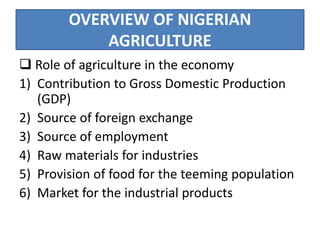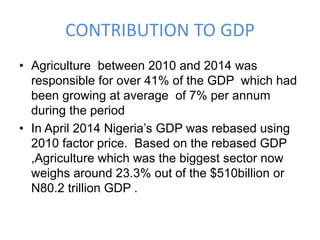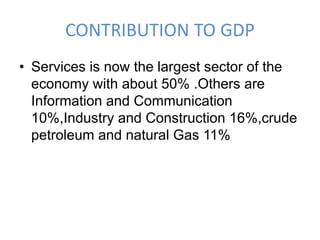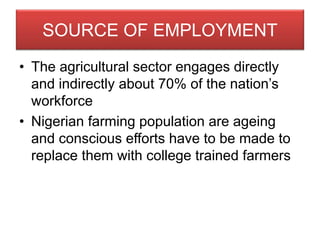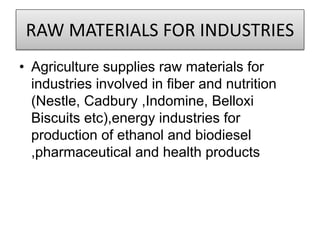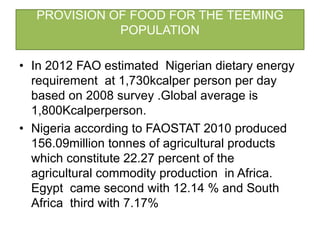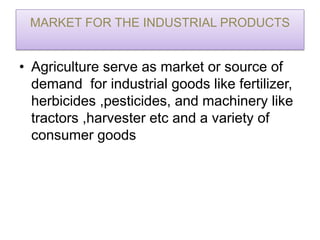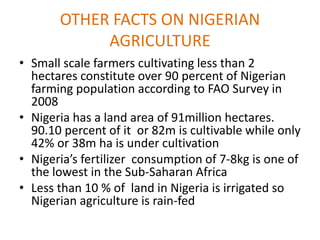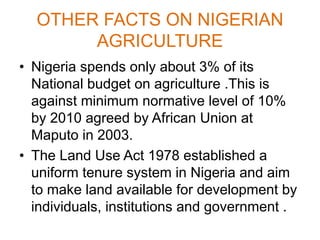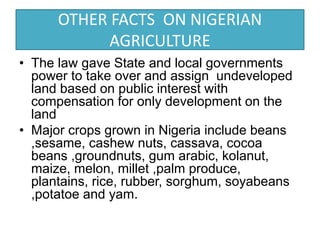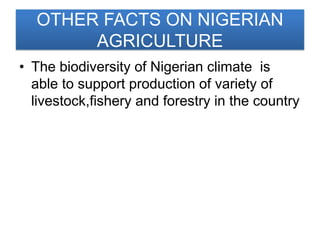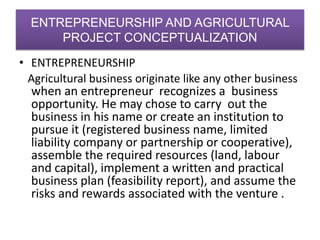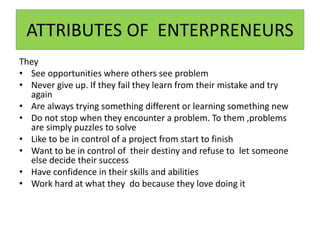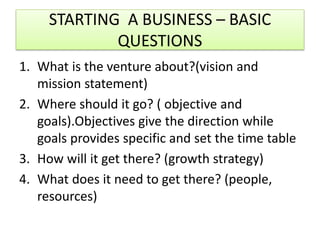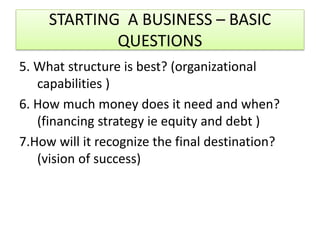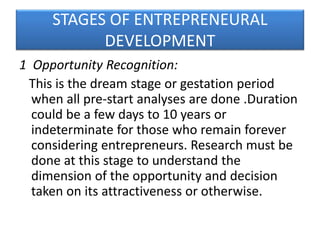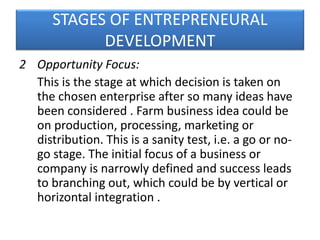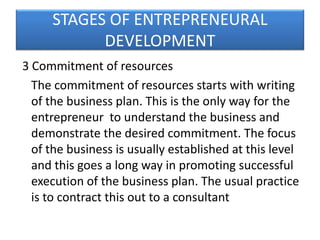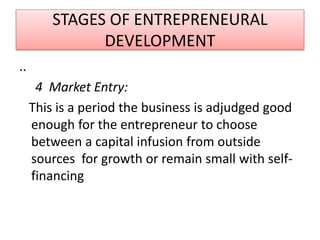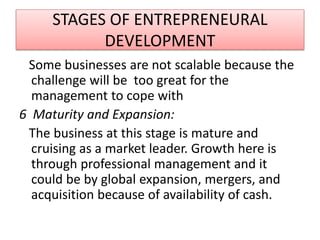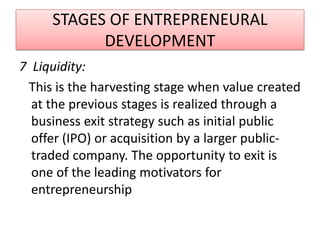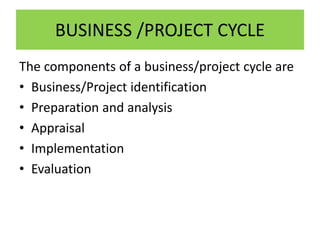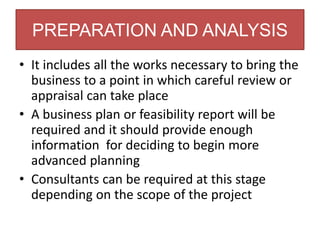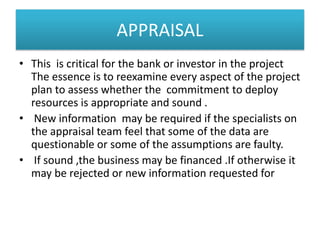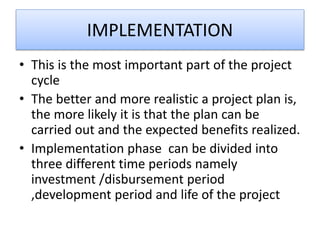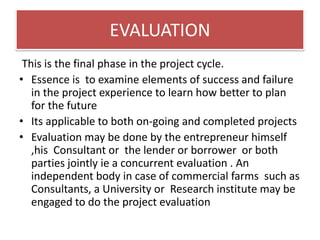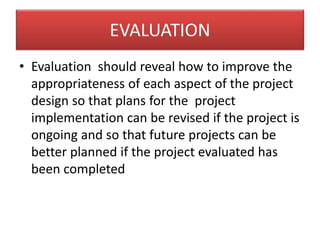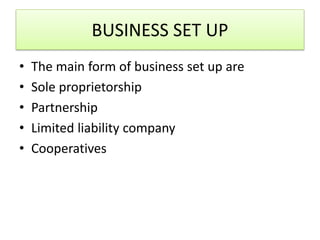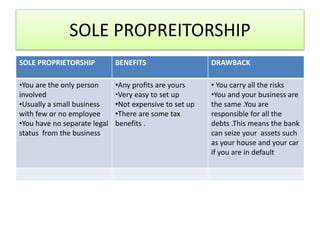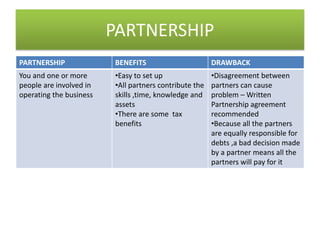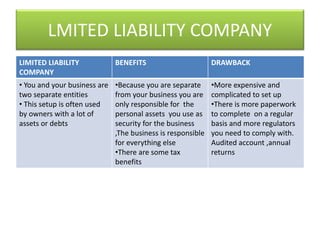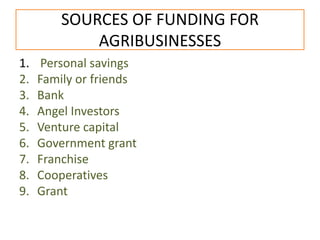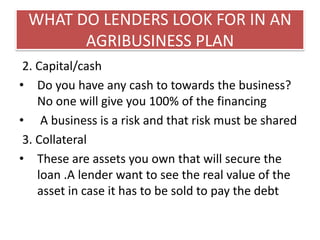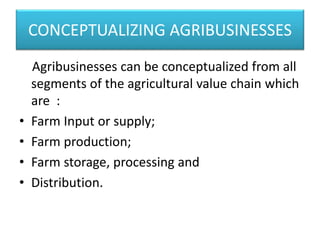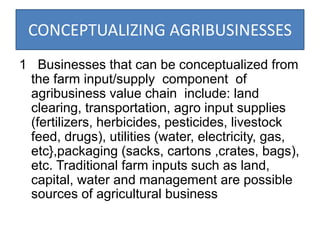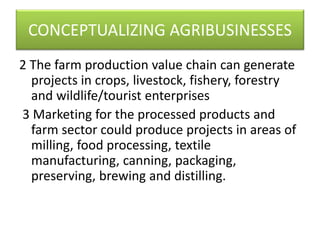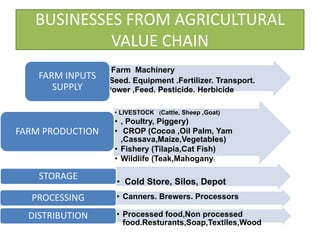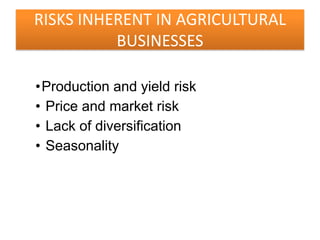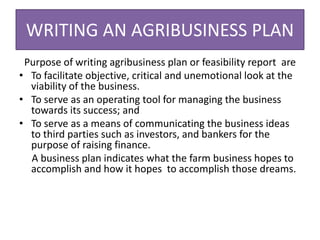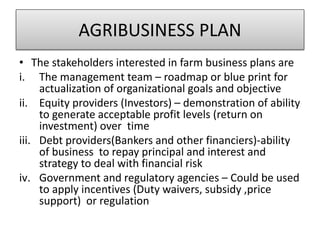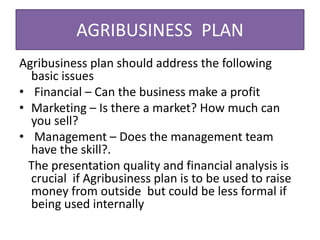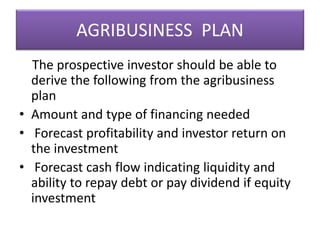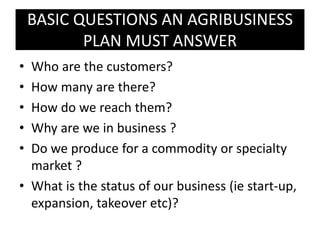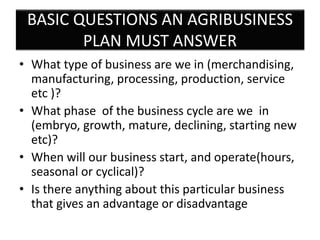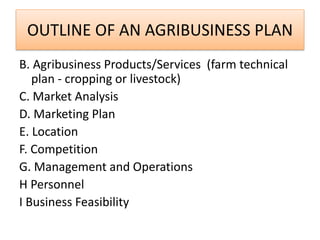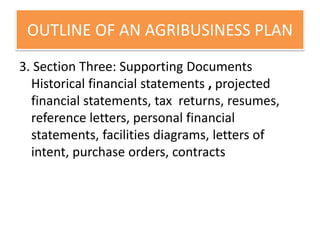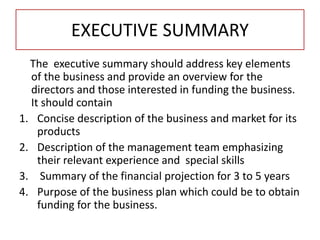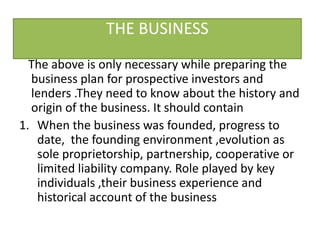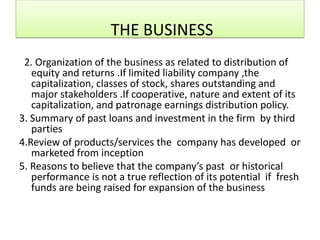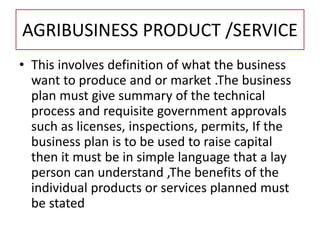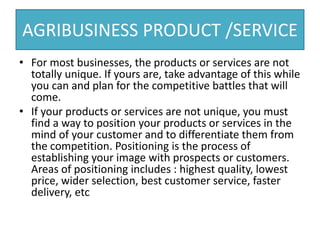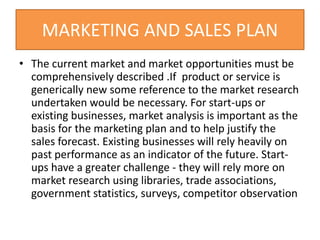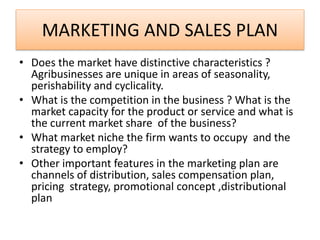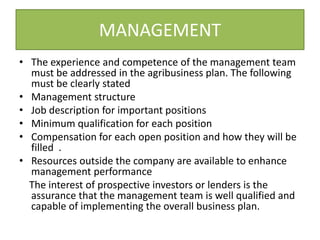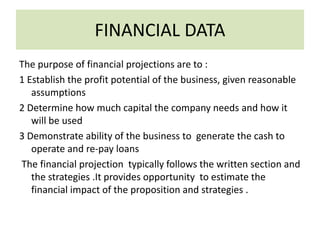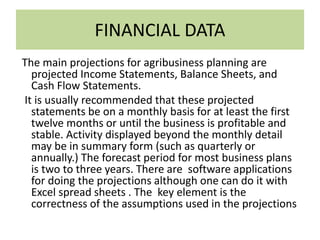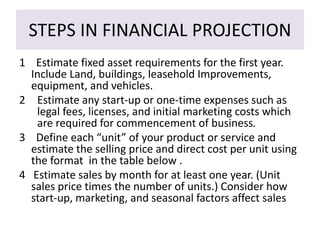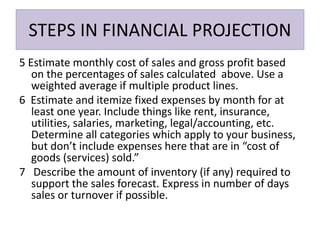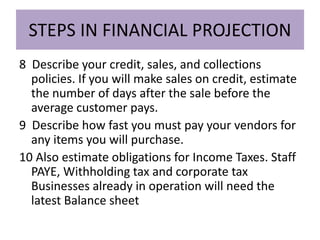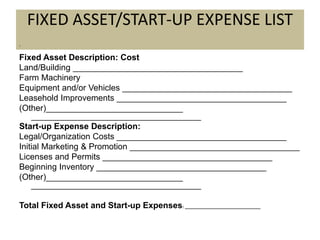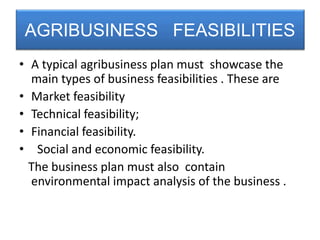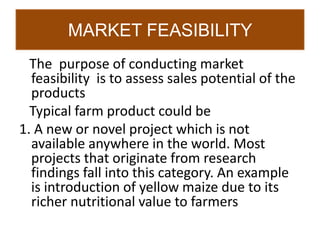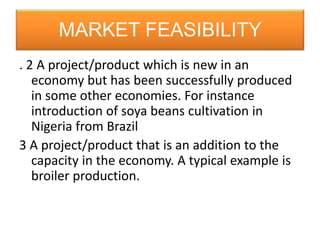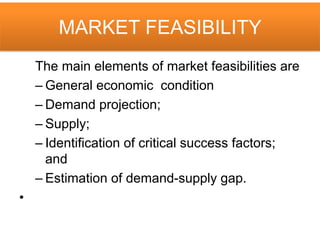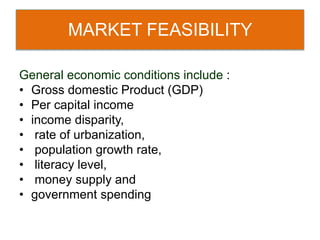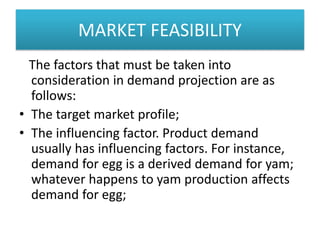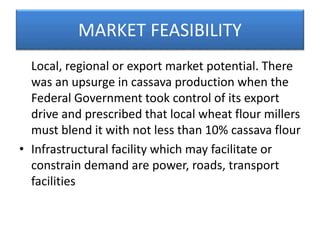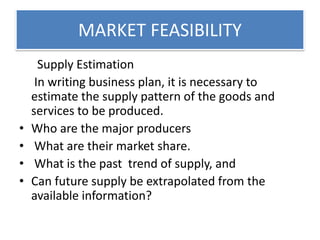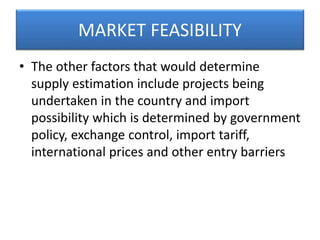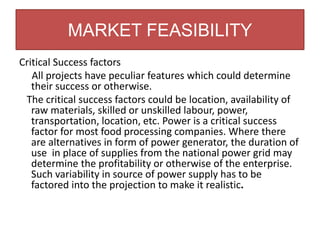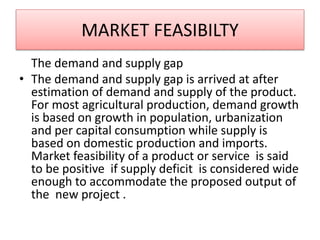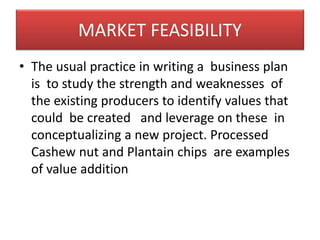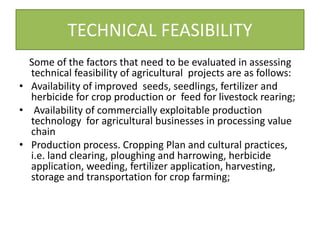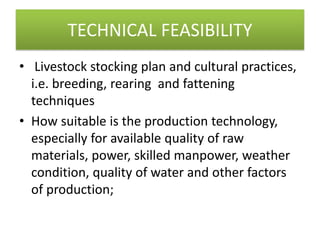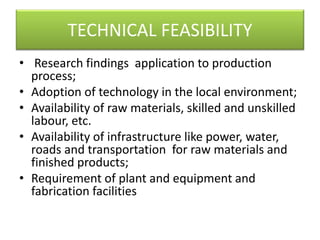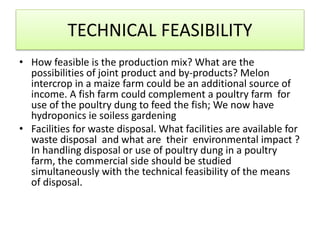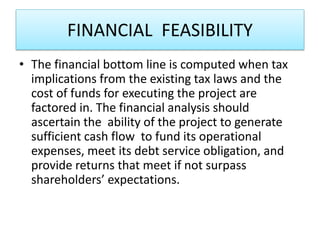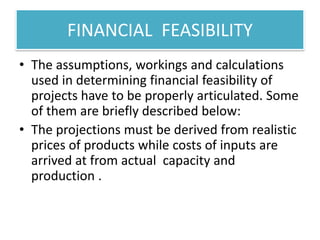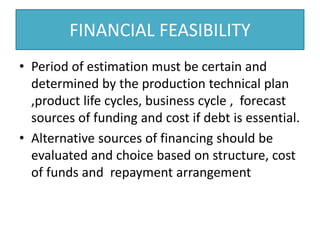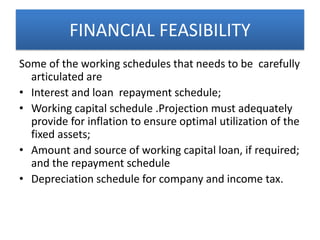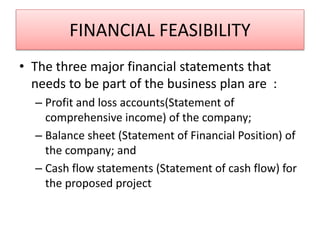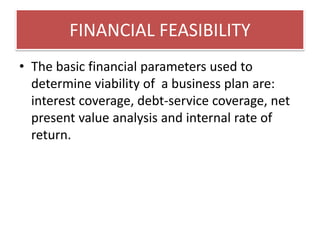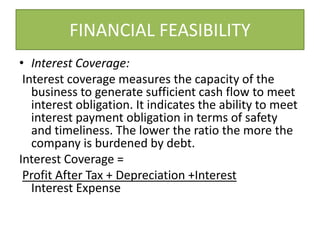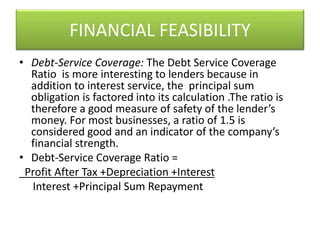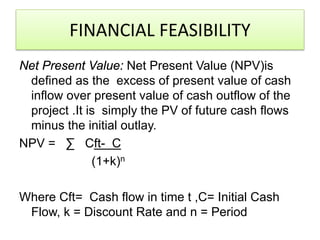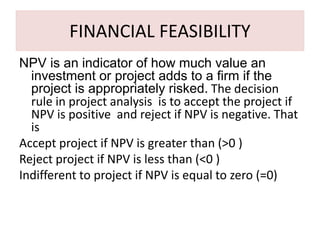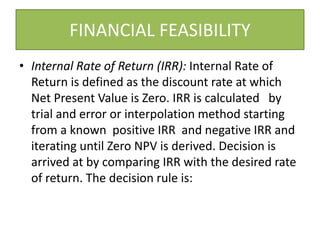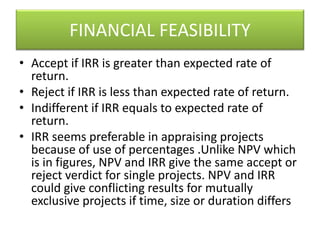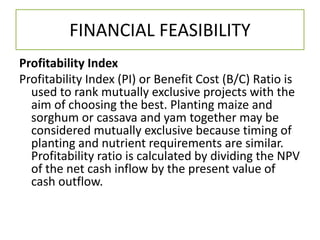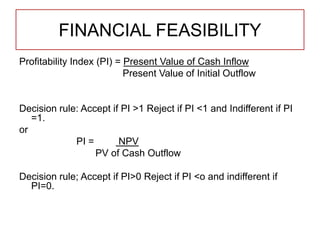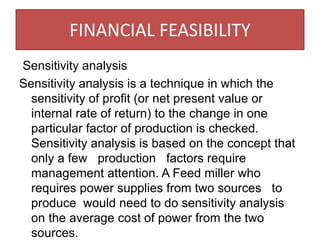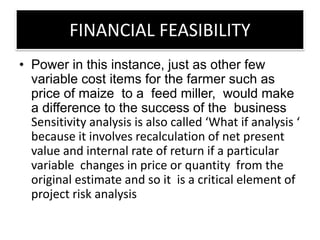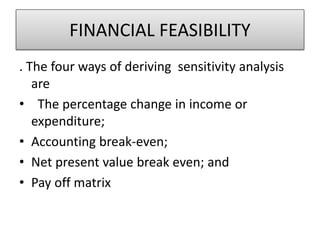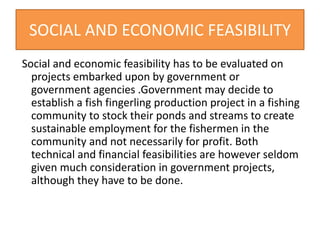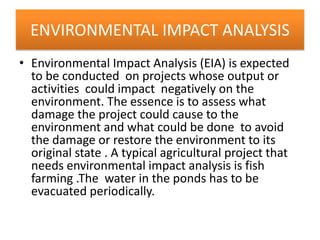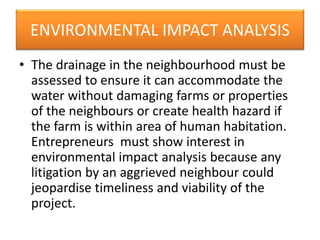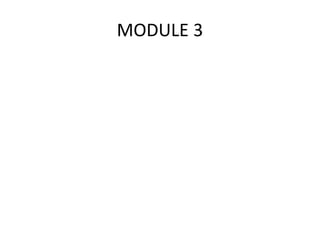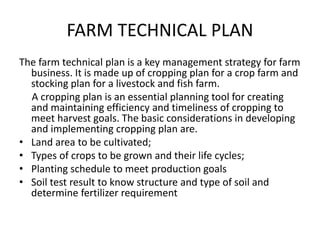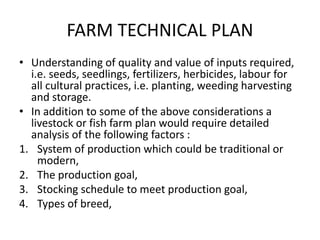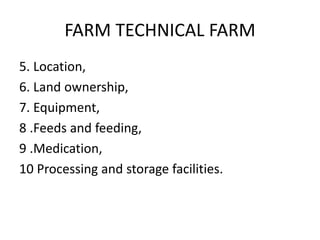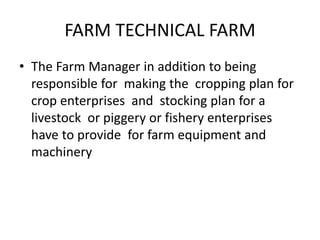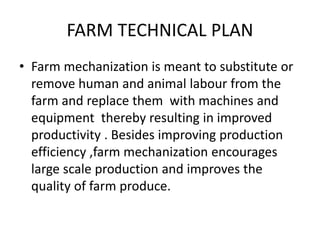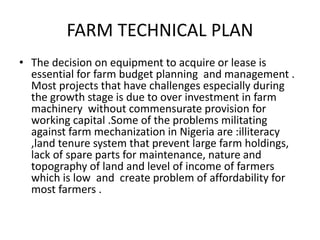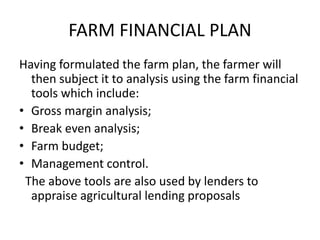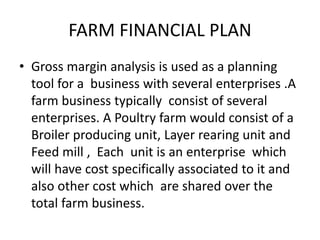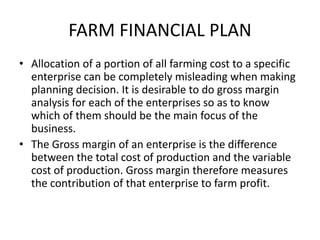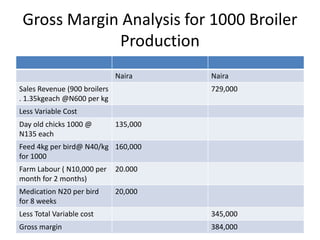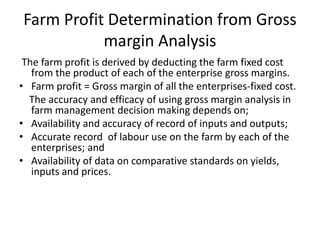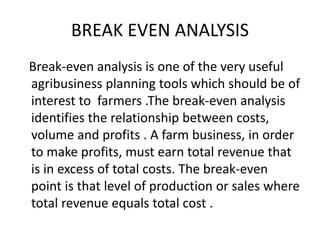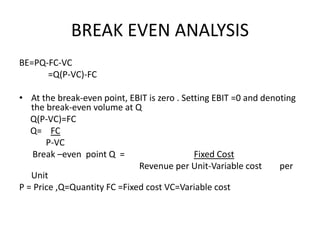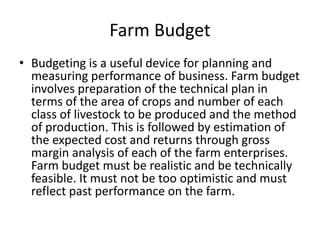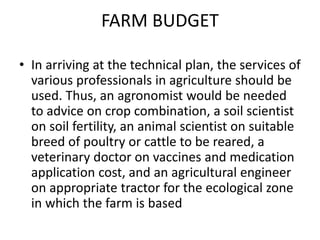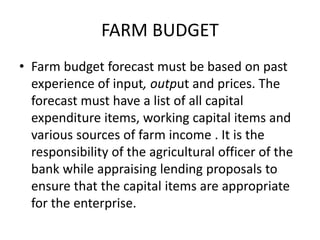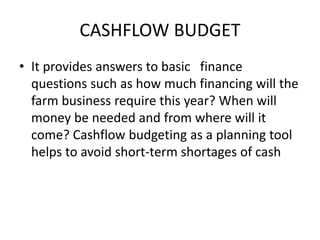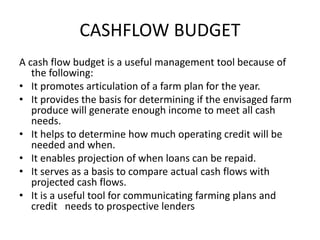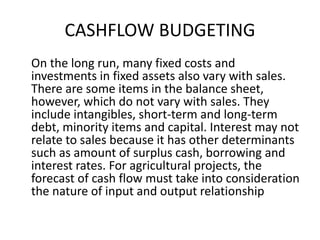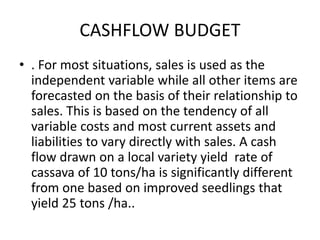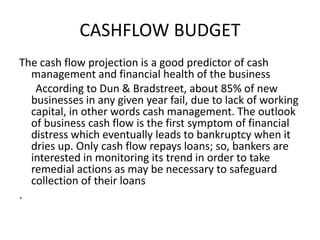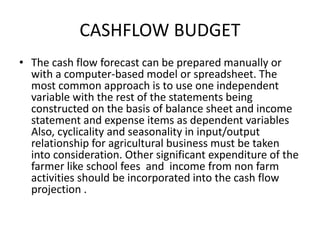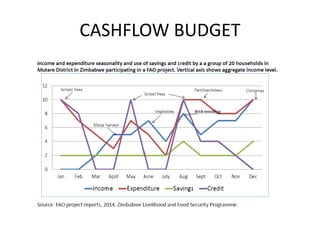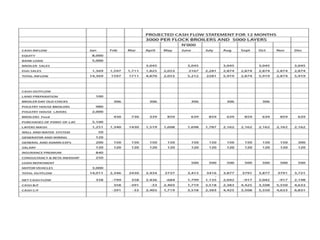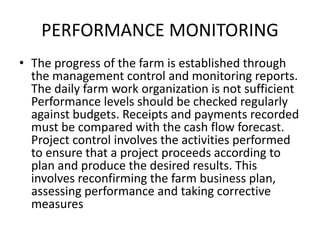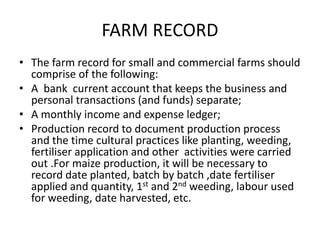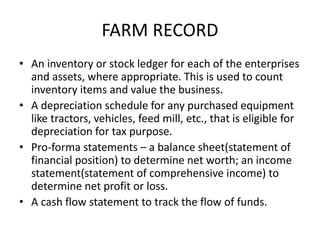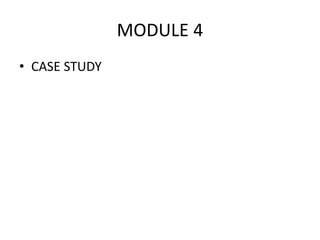Advertisement
Agribusiness business development plan
Report
Oct. 14, 2019•0 likes•4,031 views
2 likes
Be the first to like this
Show More
views
Total views
0
On Slideshare
0
From embeds
0
Number of embeds
0
Agribusiness business development plan
Oct. 14, 2019•0 likes•4,031 views
2 likes
Be the first to like this
Show More
views
Total views
0
On Slideshare
0
From embeds
0
Number of embeds
0
Download to read offline
Report
Food
Agribusiness business development plan
Advertisement
Advertisement
Advertisement
Agribusiness business development plan
- WRITING AGRIBUSINESS PLAN BOLADE AGBOLA
- LEARNING OBJECTIVE At the end of the training session each participant should be able to: 1. write an agribusiness plan 2. analyze an agribusiness plan 3. use the business plan to establish a new farm or expand an existing farm business 4. use business plan as part of the performance management tool
- Role of agriculture in the economy 1) Contribution to Gross Domestic Production (GDP) 2) Source of foreign exchange 3) Source of employment 4) Raw materials for industries 5) Provision of food for the teeming population 6) Market for the industrial products OVERVIEW OF NIGERIAN AGRICULTURE
- CONTRIBUTION TO GDP • Agriculture between 2010 and 2014 was responsible for over 41% of the GDP which had been growing at average of 7% per annum during the period • In April 2014 Nigeria’s GDP was rebased using 2010 factor price. Based on the rebased GDP ,Agriculture which was the biggest sector now weighs around 23.3% out of the $510billion or N80.2 trillion GDP .
- CONTRIBUTION TO GDP • Services is now the largest sector of the economy with about 50% .Others are Information and Communication 10%,Industry and Construction 16%,crude petroleum and natural Gas 11%
- SOURCE OF FOREIGN EXCHANGE • Only O.88% of Nigeria’s foreign exchange is generated by the Agricultural sector • The oil sector accounted for about 96.5% of the nation’s foreign exchange earnings and about 79.88% of the budgetary revenue in 2014.This should have dropped by over 60% due to declining petrol dollar inflow as crude oil currently trades at below $40 • Agricultural produce however, account for 47% of the non-oil sector foreign exchange earnings of 4.8% in 2013 .Others are: semi-manufactured goods 30.8%, manufactured goods 15.2% and solid minerals 3.8%
- SOURCE OF EMPLOYMENT • The agricultural sector engages directly and indirectly about 70% of the nation’s workforce • Nigerian farming population are ageing and conscious efforts have to be made to replace them with college trained farmers
- RAW MATERIALS FOR INDUSTRIES • Agriculture supplies raw materials for industries involved in fiber and nutrition (Nestle, Cadbury ,Indomine, Belloxi Biscuits etc),energy industries for production of ethanol and biodiesel ,pharmaceutical and health products
- PROVISION OF FOOD FOR THE TEEMING POPULATION • In 2012 FAO estimated Nigerian dietary energy requirement at 1,730kcalper person per day based on 2008 survey .Global average is 1,800Kcalperperson. • Nigeria according to FAOSTAT 2010 produced 156.09million tonnes of agricultural products which constitute 22.27 percent of the agricultural commodity production in Africa. Egypt came second with 12.14 % and South Africa third with 7.17%
- MARKET FOR THE INDUSTRIAL PRODUCTS • Agriculture serve as market or source of demand for industrial goods like fertilizer, herbicides ,pesticides, and machinery like tractors ,harvester etc and a variety of consumer goods
- OTHER FACTS ON NIGERIAN AGRICULTURE • Small scale farmers cultivating less than 2 hectares constitute over 90 percent of Nigerian farming population according to FAO Survey in 2008 • Nigeria has a land area of 91million hectares. 90.10 percent of it or 82m is cultivable while only 42% or 38m ha is under cultivation • Nigeria’s fertilizer consumption of 7-8kg is one of the lowest in the Sub-Saharan Africa • Less than 10 % of land in Nigeria is irrigated so Nigerian agriculture is rain-fed
- OTHER FACTS ON NIGERIAN AGRICULTURE • Nigeria spends only about 3% of its National budget on agriculture .This is against minimum normative level of 10% by 2010 agreed by African Union at Maputo in 2003. • The Land Use Act 1978 established a uniform tenure system in Nigeria and aim to make land available for development by individuals, institutions and government .
- OTHER FACTS ON NIGERIAN AGRICULTURE • The law gave State and local governments power to take over and assign undeveloped land based on public interest with compensation for only development on the land • Major crops grown in Nigeria include beans ,sesame, cashew nuts, cassava, cocoa beans ,groundnuts, gum arabic, kolanut, maize, melon, millet ,palm produce, plantains, rice, rubber, sorghum, soyabeans ,potatoe and yam.
- OTHER FACTS ON NIGERIAN AGRICULTURE • The biodiversity of Nigerian climate is able to support production of variety of livestock,fishery and forestry in the country
- ENTREPRENEURSHIP AND AGRICULTURAL PROJECT CONCEPTUALIZATION • ENTREPRENEURSHIP Agricultural business originate like any other business when an entrepreneur recognizes a business opportunity. He may chose to carry out the business in his name or create an institution to pursue it (registered business name, limited liability company or partnership or cooperative), assemble the required resources (land, labour and capital), implement a written and practical business plan (feasibility report), and assume the risks and rewards associated with the venture .
- ENTREPRENEURSHIP AND AGRICULTURAL PROJECT CONCEPTUALIZATION • If the farm business is successful, the rewards are many and could include wealth, fame, recognition; etc. Every business passes through five basic business cycles of start-up, growth, shake-out, maturity and ageing. Should the farm business fail due to crop failure in crop production or disease outbreak on his poultry farm in case of livestock farming he may lose his home if pledged as collateral, have to change his lifestyle and may even lose some liberty if declared bankrupt.
- A TYPICAL ENTREPRENEURIAL CYCLE
- ATTRIBUTES OF ENTERPRENEURS They • See opportunities where others see problem • Never give up. If they fail they learn from their mistake and try again • Are always trying something different or learning something new • Do not stop when they encounter a problem. To them ,problems are simply puzzles to solve • Like to be in control of a project from start to finish • Want to be in control of their destiny and refuse to let someone else decide their success • Have confidence in their skills and abilities • Work hard at what they do because they love doing it
- STARTING A BUSINESS – BASIC QUESTIONS 1. What is the venture about?(vision and mission statement) 2. Where should it go? ( objective and goals).Objectives give the direction while goals provides specific and set the time table 3. How will it get there? (growth strategy) 4. What does it need to get there? (people, resources)
- STARTING A BUSINESS – BASIC QUESTIONS 5. What structure is best? (organizational capabilities ) 6. How much money does it need and when? (financing strategy ie equity and debt ) 7.How will it recognize the final destination? (vision of success)
- STAGES OF ENTREPRENEURAL DEVELOPMENT 1 Opportunity Recognition: This is the dream stage or gestation period when all pre-start analyses are done .Duration could be a few days to 10 years or indeterminate for those who remain forever considering entrepreneurs. Research must be done at this stage to understand the dimension of the opportunity and decision taken on its attractiveness or otherwise.
- STAGES OF ENTREPRENEURAL DEVELOPMENT 2 Opportunity Focus: This is the stage at which decision is taken on the chosen enterprise after so many ideas have been considered . Farm business idea could be on production, processing, marketing or distribution. This is a sanity test, i.e. a go or no- go stage. The initial focus of a business or company is narrowly defined and success leads to branching out, which could be by vertical or horizontal integration .
- STAGES OF ENTREPRENEURAL DEVELOPMENT 3 Commitment of resources The commitment of resources starts with writing of the business plan. This is the only way for the entrepreneur to understand the business and demonstrate the desired commitment. The focus of the business is usually established at this level and this goes a long way in promoting successful execution of the business plan. The usual practice is to contract this out to a consultant
- STAGES OF ENTREPRENEURAL DEVELOPMENT .. 4 Market Entry: This is a period the business is adjudged good enough for the entrepreneur to choose between a capital infusion from outside sources for growth or remain small with self- financing
- STAGES OF ENTREPRENEURAL DEVELOPMENT 5 Full Launch and Growth: This is a stage the entrepreneur must choose a particular high growth business strategy or remain a small business operating as a sole proprietor. Most small businesses will remain small because not all small businesses can become big companies.. This is because there is just not enough room in the market for growth as their production and management are not scalable
- STAGES OF ENTREPRENEURAL DEVELOPMENT Some businesses are not scalable because the challenge will be too great for the management to cope with 6 Maturity and Expansion: The business at this stage is mature and cruising as a market leader. Growth here is through professional management and it could be by global expansion, mergers, and acquisition because of availability of cash.
- STAGES OF ENTREPRENEURAL DEVELOPMENT 7 Liquidity: This is the harvesting stage when value created at the previous stages is realized through a business exit strategy such as initial public offer (IPO) or acquisition by a larger public- traded company. The opportunity to exit is one of the leading motivators for entrepreneurship
- BUSINESS /PROJECT CYCLE The components of a business/project cycle are • Business/Project identification • Preparation and analysis • Appraisal • Implementation • Evaluation
- BUSINESS IDENTIFICATION • First stage is to identify potential business • Sources could include consultants ,market trend ,import and export statistics
- PREPARATION AND ANALYSIS • It includes all the works necessary to bring the business to a point in which careful review or appraisal can take place • A business plan or feasibility report will be required and it should provide enough information for deciding to begin more advanced planning • Consultants can be required at this stage depending on the scope of the project
- APPRAISAL • This is critical for the bank or investor in the project The essence is to reexamine every aspect of the project plan to assess whether the commitment to deploy resources is appropriate and sound . • New information may be required if the specialists on the appraisal team feel that some of the data are questionable or some of the assumptions are faulty. • If sound ,the business may be financed .If otherwise it may be rejected or new information requested for
- IMPLEMENTATION • This is the most important part of the project cycle • The better and more realistic a project plan is, the more likely it is that the plan can be carried out and the expected benefits realized. • Implementation phase can be divided into three different time periods namely investment /disbursement period ,development period and life of the project
- EVALUATION This is the final phase in the project cycle. • Essence is to examine elements of success and failure in the project experience to learn how better to plan for the future • Its applicable to both on-going and completed projects • Evaluation may be done by the entrepreneur himself ,his Consultant or the lender or borrower or both parties jointly ie a concurrent evaluation . An independent body in case of commercial farms such as Consultants, a University or Research institute may be engaged to do the project evaluation
- EVALUATION • Evaluation should reveal how to improve the appropriateness of each aspect of the project design so that plans for the project implementation can be revised if the project is ongoing and so that future projects can be better planned if the project evaluated has been completed
- BUSINESS SET UP • The main form of business set up are • Sole proprietorship • Partnership • Limited liability company • Cooperatives
- SOLE PROPREITORSHIP SOLE PROPRIETORSHIP BENEFITS DRAWBACK •You are the only person involved •Usually a small business with few or no employee •You have no separate legal status from the business •Any profits are yours •Very easy to set up •Not expensive to set up •There are some tax benefits . • You carry all the risks •You and your business are the same .You are responsible for all the debts .This means the bank can seize your assets such as your house and your car if you are in default
- PARTNERSHIP PARTNERSHIP BENEFITS DRAWBACK You and one or more people are involved in operating the business •Easy to set up •All partners contribute the skills ,time, knowledge and assets •There are some tax benefits •Disagreement between partners can cause problem – Written Partnership agreement recommended •Because all the partners are equally responsible for debts ,a bad decision made by a partner means all the partners will pay for it
- LMITED LIABILITY COMPANY LIMITED LIABILITY COMPANY BENEFITS DRAWBACK • You and your business are two separate entities • This setup is often used by owners with a lot of assets or debts •Because you are separate from your business you are only responsible for the personal assets you use as security for the business ,The business is responsible for everything else •There are some tax benefits •More expensive and complicated to set up •There is more paperwork to complete on a regular basis and more regulators you need to comply with. Audited account ,annual returns
- COOPERATIVES Cooperatives Benefits Drawback Union of persons formed for the production and marketing of goods for their common benefits Its voluntarily owned and controlled by its members and operated for them and by them on non-profit and cost basis There are some tax benefits Commitment of Leaders and majority investors tend to wane after they have been served and so it becomes difficult to keep it going
- SOURCES OF FUNDING FOR AGRIBUSINESSES 1. Personal savings 2. Family or friends 3. Bank 4. Angel Investors 5. Venture capital 6. Government grant 7. Franchise 8. Cooperatives 9. Grant
- WHAT DO LENDERS LOOK FOR IN AN AGRIBUSINESS PLAN What lenders and investors want to see in agribusiness plan are indicated in the 5 Cs of credit which are : 1. Character • Can you provide good personal references, employment references and credit reference • Can you show that once you take obligation you will see it through to the end • Can you show you have the skills, knowledge and experience needed for the business
- WHAT DO LENDERS LOOK FOR IN AN AGRIBUSINESS PLAN 2. Capital/cash • Do you have any cash to towards the business? No one will give you 100% of the financing • A business is a risk and that risk must be shared 3. Collateral • These are assets you own that will secure the loan .A lender want to see the real value of the asset in case it has to be sold to pay the debt
- WHAT DO LENDERS LOOK FOR IN AN AGRIBUSINESS PLAN 4. Capacity • Will there be enough profit to make the loan payments in addition to the operating expense ,wages and living expenses ? • Can the business generate sufficient profits for the investors to share and when? 5. Conditions • What are social conditions of the area ? What is the population. Can the business be successfully carried out in the environment ? • What are the economic conditions ?Is there a high employment rate? Is the economy growing or contracting ? • What laws and regulations could affect business
- WHAT DO INVESTORS LOOK FOR IN A BUSINESS VENTURE
- CONCEPTUALIZING AGRIBUSINESSES Agribusinesses can be conceptualized from all segments of the agricultural value chain which are : • Farm Input or supply; • Farm production; • Farm storage, processing and • Distribution.
- CONCEPTUALIZING AGRIBUSINESSES 1 Businesses that can be conceptualized from the farm input/supply component of agribusiness value chain include: land clearing, transportation, agro input supplies (fertilizers, herbicides, pesticides, livestock feed, drugs), utilities (water, electricity, gas, etc},packaging (sacks, cartons ,crates, bags), etc. Traditional farm inputs such as land, capital, water and management are possible sources of agricultural business
- CONCEPTUALIZING AGRIBUSINESSES 2 The farm production value chain can generate projects in crops, livestock, fishery, forestry and wildlife/tourist enterprises 3 Marketing for the processed products and farm sector could produce projects in areas of milling, food processing, textile manufacturing, canning, packaging, preserving, brewing and distilling.
- BUSINESSES FROM AGRICULTURAL VALUE CHAIN •Farm Machinery •Seed. Equipment .Fertilizer. Transport. Power ,Feed. Pesticide. Herbicide FARM INPUTS SUPPLY • LIVESTOCK (Cattle, Sheep ,Goat) • , Poultry, Piggery) • CROP (Cocoa ,Oil Palm, Yam ,Cassava,Maize,Vegetables) • Fishery (Tilapia,Cat Fish) • Wildlife (Teak,Mahogany) FARM PRODUCTION • Cold Store, Silos, Depot STORAGE • Canners. Brewers. ProcessorsPROCESSING • Processed food,Non processed food.Resturants,Soap,Textiles,Wood DISTRIBUTION
- RISKS INHERENT IN AGRICULTURAL BUSINESSES •Production and yield risk • Price and market risk • Lack of diversification • Seasonality
- MODULE 2
- WRITING AN AGRIBUSINESS PLAN Purpose of writing agribusiness plan or feasibility report are • To facilitate objective, critical and unemotional look at the viability of the business. • To serve as an operating tool for managing the business towards its success; and • To serve as a means of communicating the business ideas to third parties such as investors, and bankers for the purpose of raising finance. A business plan indicates what the farm business hopes to accomplish and how it hopes to accomplish those dreams.
- AGRIBUSINESS PLAN • The stakeholders interested in farm business plans are i. The management team – roadmap or blue print for actualization of organizational goals and objective ii. Equity providers (Investors) – demonstration of ability to generate acceptable profit levels (return on investment) over time iii. Debt providers(Bankers and other financiers)-ability of business to repay principal and interest and strategy to deal with financial risk iv. Government and regulatory agencies – Could be used to apply incentives (Duty waivers, subsidy ,price support) or regulation
- AGRIBUSINESS PLAN Agribusiness plan should address the following basic issues • Financial – Can the business make a profit • Marketing – Is there a market? How much can you sell? • Management – Does the management team have the skill?. The presentation quality and financial analysis is crucial if Agribusiness plan is to be used to raise money from outside but could be less formal if being used internally
- AGRIBUSINESS PLAN The prospective investor should be able to derive the following from the agribusiness plan • Amount and type of financing needed • Forecast profitability and investor return on the investment • Forecast cash flow indicating liquidity and ability to repay debt or pay dividend if equity investment
- BASIC QUESTIONS AN AGRIBUSINESS PLAN MUST ANSWER • Who are the customers? • How many are there? • How do we reach them? • Why are we in business ? • Do we produce for a commodity or specialty market ? • What is the status of our business (ie start-up, expansion, takeover etc)?
- BASIC QUESTIONS AN AGRIBUSINESS PLAN MUST ANSWER • What type of business are we in (merchandising, manufacturing, processing, production, service etc )? • What phase of the business cycle are we in (embryo, growth, mature, declining, starting new etc)? • When will our business start, and operate(hours, seasonal or cyclical)? • Is there anything about this particular business that gives an advantage or disadvantage
- OUTLINE OF AN AGRIBUSINESS PLAN Cover Sheet: Business Name, Address, Phone Number, Principals Executive Summary or Statement of Purpose Table of Contents 1. Section One: The Business A. Description of Business (History of the company ,agribusiness , organizational structure and background)
- OUTLINE OF AN AGRIBUSINESS PLAN B. Agribusiness Products/Services (farm technical plan - cropping or livestock) C. Market Analysis D. Marketing Plan E. Location F. Competition G. Management and Operations H Personnel I Business Feasibility
- OUTLINE OF AN AGRIBUSINESS PLAN 2 Section Two: Financial Data A. Projected Financial Statements • Income Statements • Cash Flow Statements • Balance Sheets • Assumptions to Projected Financial Statements B. Break Even Analysis C. Gross margin Analysis D. Sources and Uses of Funds
- OUTLINE OF AN AGRIBUSINESS PLAN 3. Section Three: Supporting Documents Historical financial statements , projected financial statements, tax returns, resumes, reference letters, personal financial statements, facilities diagrams, letters of intent, purchase orders, contracts
- EXECUTIVE SUMMARY The executive summary should address key elements of the business and provide an overview for the directors and those interested in funding the business. It should contain 1. Concise description of the business and market for its products 2. Description of the management team emphasizing their relevant experience and special skills 3. Summary of the financial projection for 3 to 5 years 4. Purpose of the business plan which could be to obtain funding for the business.
- THE BUSINESS The above is only necessary while preparing the business plan for prospective investors and lenders .They need to know about the history and origin of the business. It should contain 1. When the business was founded, progress to date, the founding environment ,evolution as sole proprietorship, partnership, cooperative or limited liability company. Role played by key individuals ,their business experience and historical account of the business
- THE BUSINESS 2. Organization of the business as related to distribution of equity and returns .If limited liability company ,the capitalization, classes of stock, shares outstanding and major stakeholders .If cooperative, nature and extent of its capitalization, and patronage earnings distribution policy. 3. Summary of past loans and investment in the firm by third parties 4.Review of products/services the company has developed or marketed from inception 5. Reasons to believe that the company’s past or historical performance is not a true reflection of its potential if fresh funds are being raised for expansion of the business
- AGRIBUSINESS PRODUCT /SERVICE • This involves definition of what the business want to produce and or market .The business plan must give summary of the technical process and requisite government approvals such as licenses, inspections, permits, If the business plan is to be used to raise capital then it must be in simple language that a lay person can understand ,The benefits of the individual products or services planned must be stated
- AGRIBUSINESS PRODUCT /SERVICE • For most businesses, the products or services are not totally unique. If yours are, take advantage of this while you can and plan for the competitive battles that will come. • If your products or services are not unique, you must find a way to position your products or services in the mind of your customer and to differentiate them from the competition. Positioning is the process of establishing your image with prospects or customers. Areas of positioning includes : highest quality, lowest price, wider selection, best customer service, faster delivery, etc
- MARKETING AND SALES PLAN • The current market and market opportunities must be comprehensively described .If product or service is generically new some reference to the market research undertaken would be necessary. For start-ups or existing businesses, market analysis is important as the basis for the marketing plan and to help justify the sales forecast. Existing businesses will rely heavily on past performance as an indicator of the future. Start- ups have a greater challenge - they will rely more on market research using libraries, trade associations, government statistics, surveys, competitor observation
- MARKETING AND SALES PLAN Some of the questions that should be answered by the plan are : • Who are the customers ? geographic, demographic and psychographic(study personality, values, opinion, attitude interests and lifestyle) characteristics • What is the historical status ? • Where are your present and future markets ? • At what level does your firm make marketing decision? • How do you sell your product and services ? • What characteristics are most critical to your production process and successful sale of your firm’s products or services ?
- MARKETING AND SALES PLAN • What is the size of the market? Is it growing? • Any prospect for export? • What is (will be) your share? How will your share change over time? • What is the industry outlook? • Are there segments of users who are under- served by competition? Do any of these under-served segments present opportunities
- MARKETING AND SALES PLAN • Does the market have distinctive characteristics ? Agribusinesses are unique in areas of seasonality, perishability and cyclicality. • What is the competition in the business ? What is the market capacity for the product or service and what is the current market share of the business? • What market niche the firm wants to occupy and the strategy to employ? • Other important features in the marketing plan are channels of distribution, sales compensation plan, pricing strategy, promotional concept ,distributional plan
- MANAGEMENT • The experience and competence of the management team must be addressed in the agribusiness plan. The following must be clearly stated • Management structure • Job description for important positions • Minimum qualification for each position • Compensation for each open position and how they will be filled . • Resources outside the company are available to enhance management performance The interest of prospective investors or lenders is the assurance that the management team is well qualified and capable of implementing the overall business plan.
- FINANCIAL DATA The purpose of financial projections are to : 1 Establish the profit potential of the business, given reasonable assumptions 2 Determine how much capital the company needs and how it will be used 3 Demonstrate ability of the business to generate the cash to operate and re-pay loans The financial projection typically follows the written section and the strategies .It provides opportunity to estimate the financial impact of the proposition and strategies .
- FINANCIAL DATA The main projections for agribusiness planning are projected Income Statements, Balance Sheets, and Cash Flow Statements. It is usually recommended that these projected statements be on a monthly basis for at least the first twelve months or until the business is profitable and stable. Activity displayed beyond the monthly detail may be in summary form (such as quarterly or annually.) The forecast period for most business plans is two to three years. There are software applications for doing the projections although one can do it with Excel spread sheets . The key element is the correctness of the assumptions used in the projections
- STEPS IN FINANCIAL PROJECTION 1 Estimate fixed asset requirements for the first year. Include Land, buildings, leasehold Improvements, equipment, and vehicles. 2 Estimate any start-up or one-time expenses such as legal fees, licenses, and initial marketing costs which are required for commencement of business. 3 Define each “unit” of your product or service and estimate the selling price and direct cost per unit using the format in the table below . 4 Estimate sales by month for at least one year. (Unit sales price times the number of units.) Consider how start-up, marketing, and seasonal factors affect sales
- STEPS IN FINANCIAL PROJECTION 5 Estimate monthly cost of sales and gross profit based on the percentages of sales calculated above. Use a weighted average if multiple product lines. 6 Estimate and itemize fixed expenses by month for at least one year. Include things like rent, insurance, utilities, salaries, marketing, legal/accounting, etc. Determine all categories which apply to your business, but don’t include expenses here that are in “cost of goods (services) sold.” 7 Describe the amount of inventory (if any) required to support the sales forecast. Express in number of days sales or turnover if possible.
- STEPS IN FINANCIAL PROJECTION 8 Describe your credit, sales, and collections policies. If you will make sales on credit, estimate the number of days after the sale before the average customer pays. 9 Describe how fast you must pay your vendors for any items you will purchase. 10 Also estimate obligations for Income Taxes. Staff PAYE, Withholding tax and corporate tax Businesses already in operation will need the latest Balance sheet
- FIXED ASSET/START-UP EXPENSE LIST : Fixed Asset Description: Cost Land/Building ____________________________________ Farm Machinery Equipment and/or Vehicles ____________________________________ Leasehold Improvements ____________________________________ (Other)_____________________________ ____________________________________ Start-up Expense Description: Legal/Organization Costs ____________________________________ Initial Marketing & Promotion ____________________________________ Licenses and Permits ____________________________________ Beginning Inventory ____________________________________ (Other)_____________________________ ____________________________________ Total Fixed Asset and Start-up Expenses: _______________________________
- UNIT SELLING PRICE AND COST ANALYSIS Product or Service : A. Selling Price : _____________ less Direct Costs: Farm Inputs (Seed, Fertilizer, Herbicides) _____ Family Labor _____ Hired Labour ______ (Other) ______ _____________________ ___________ B. Total Cost per Unit ____________ C. Unit Gross Profit (A minus B) ____________ D. Gross Profit % (C divided by A) ____________
- AGRIBUSINESS FEASIBILITIES • A typical agribusiness plan must showcase the main types of business feasibilities . These are • Market feasibility • Technical feasibility; • Financial feasibility. • Social and economic feasibility. The business plan must also contain environmental impact analysis of the business .
- MARKET FEASIBILITY The purpose of conducting market feasibility is to assess sales potential of the products Typical farm product could be 1. A new or novel project which is not available anywhere in the world. Most projects that originate from research findings fall into this category. An example is introduction of yellow maize due to its richer nutritional value to farmers
- MARKET FEASIBILITY . 2 A project/product which is new in an economy but has been successfully produced in some other economies. For instance introduction of soya beans cultivation in Nigeria from Brazil 3 A project/product that is an addition to the capacity in the economy. A typical example is broiler production.
- MARKET FEASIBILITY The main elements of market feasibilities are – General economic condition – Demand projection; – Supply; – Identification of critical success factors; and – Estimation of demand-supply gap. •
- MARKET FEASIBILITY General economic conditions include : • Gross domestic Product (GDP) • Per capital income • income disparity, • rate of urbanization, • population growth rate, • literacy level, • money supply and • government spending
- MARKET FEASIBILITY These are the determinants of the demand potential of the goods and services to be produced and must be analyzed
- MARKET FEASIBILITY The factors that must be taken into consideration in demand projection are as follows: • The target market profile; • The influencing factor. Product demand usually has influencing factors. For instance, demand for egg is a derived demand for yam; whatever happens to yam production affects demand for egg;
- MARKET FEASIBILITY Local, regional or export market potential. There was an upsurge in cassava production when the Federal Government took control of its export drive and prescribed that local wheat flour millers must blend it with not less than 10% cassava flour • Infrastructural facility which may facilitate or constrain demand are power, roads, transport facilities
- MARKET FEASIBILITY Supply Estimation In writing business plan, it is necessary to estimate the supply pattern of the goods and services to be produced. • Who are the major producers • What are their market share. • What is the past trend of supply, and • Can future supply be extrapolated from the available information?
- MARKET FEASIBILITY • The other factors that would determine supply estimation include projects being undertaken in the country and import possibility which is determined by government policy, exchange control, import tariff, international prices and other entry barriers
- MARKET FEASIBILITY Critical Success factors All projects have peculiar features which could determine their success or otherwise. The critical success factors could be location, availability of raw materials, skilled or unskilled labour, power, transportation, location, etc. Power is a critical success factor for most food processing companies. Where there are alternatives in form of power generator, the duration of use in place of supplies from the national power grid may determine the profitability or otherwise of the enterprise. Such variability in source of power supply has to be factored into the projection to make it realistic.
- MARKET FEASIBILTY The demand and supply gap • The demand and supply gap is arrived at after estimation of demand and supply of the product. For most agricultural production, demand growth is based on growth in population, urbanization and per capital consumption while supply is based on domestic production and imports. Market feasibility of a product or service is said to be positive if supply deficit is considered wide enough to accommodate the proposed output of the new project .
- MARKET FEASIBILITY • The usual practice in writing a business plan is to study the strength and weaknesses of the existing producers to identify values that could be created and leverage on these in conceptualizing a new project. Processed Cashew nut and Plantain chips are examples of value addition
- TECHNICAL FEASIBILITY Some of the factors that need to be evaluated in assessing technical feasibility of agricultural projects are as follows: • Availability of improved seeds, seedlings, fertilizer and herbicide for crop production or feed for livestock rearing; • Availability of commercially exploitable production technology for agricultural businesses in processing value chain • Production process. Cropping Plan and cultural practices, i.e. land clearing, ploughing and harrowing, herbicide application, weeding, fertilizer application, harvesting, storage and transportation for crop farming;
- TECHNICAL FEASIBILITY • Livestock stocking plan and cultural practices, i.e. breeding, rearing and fattening techniques • How suitable is the production technology, especially for available quality of raw materials, power, skilled manpower, weather condition, quality of water and other factors of production;
- TECHNICAL FEASIBILITY • Research findings application to production process; • Adoption of technology in the local environment; • Availability of raw materials, skilled and unskilled labour, etc. • Availability of infrastructure like power, water, roads and transportation for raw materials and finished products; • Requirement of plant and equipment and fabrication facilities
- TECHNICAL FEASIBILITY • How feasible is the production mix? What are the possibilities of joint product and by-products? Melon intercrop in a maize farm could be an additional source of income. A fish farm could complement a poultry farm for use of the poultry dung to feed the fish; We now have hydroponics ie soiless gardening • Facilities for waste disposal. What facilities are available for waste disposal and what are their environmental impact ? In handling disposal or use of poultry dung in a poultry farm, the commercial side should be studied simultaneously with the technical feasibility of the means of disposal.
- FINANCIAL FEASIBILITY • Financial feasibility assessment involves a detailed financial analysis. This is where the demand and prices derived from market feasibility and the project cost and operating cost obtained from technical feasibility report are combined to determine the viability of the project.
- FINANCIAL FEASIBILITY • The financial bottom line is computed when tax implications from the existing tax laws and the cost of funds for executing the project are factored in. The financial analysis should ascertain the ability of the project to generate sufficient cash flow to fund its operational expenses, meet its debt service obligation, and provide returns that meet if not surpass shareholders’ expectations.
- FINANCIAL FEASIBILITY • The assumptions, workings and calculations used in determining financial feasibility of projects have to be properly articulated. Some of them are briefly described below: • The projections must be derived from realistic prices of products while costs of inputs are arrived at from actual capacity and production .
- FINANCIAL FEASIBILITY • Period of estimation must be certain and determined by the production technical plan ,product life cycles, business cycle , forecast sources of funding and cost if debt is essential. • Alternative sources of financing should be evaluated and choice based on structure, cost of funds and repayment arrangement
- FINANCIAL FEASIBILITY Some of the working schedules that needs to be carefully articulated are • Interest and loan repayment schedule; • Working capital schedule .Projection must adequately provide for inflation to ensure optimal utilization of the fixed assets; • Amount and source of working capital loan, if required; and the repayment schedule • Depreciation schedule for company and income tax.
- FINANCIAL FEASIBILITY • The three major financial statements that needs to be part of the business plan are : – Profit and loss accounts(Statement of comprehensive income) of the company; – Balance sheet (Statement of Financial Position) of the company; and – Cash flow statements (Statement of cash flow) for the proposed project
- FINANCIAL FEASIBILITY • The basic financial parameters used to determine viability of a business plan are: interest coverage, debt-service coverage, net present value analysis and internal rate of return.
- FINANCIAL FEASIBILITY • Interest Coverage: Interest coverage measures the capacity of the business to generate sufficient cash flow to meet interest obligation. It indicates the ability to meet interest payment obligation in terms of safety and timeliness. The lower the ratio the more the company is burdened by debt. Interest Coverage = Profit After Tax + Depreciation +Interest Interest Expense
- FINANCIAL FEASIBILITY • Debt-Service Coverage: The Debt Service Coverage Ratio is more interesting to lenders because in addition to interest service, the principal sum obligation is factored into its calculation .The ratio is therefore a good measure of safety of the lender’s money. For most businesses, a ratio of 1.5 is considered good and an indicator of the company’s financial strength. • Debt-Service Coverage Ratio = Profit After Tax +Depreciation +Interest Interest +Principal Sum Repayment
- FINANCIAL FEASIBILITY Net Present Value: Net Present Value (NPV)is defined as the excess of present value of cash inflow over present value of cash outflow of the project .It is simply the PV of future cash flows minus the initial outlay. NPV = ∑ Cft- C (1+k)n Where Cft= Cash flow in time t ,C= Initial Cash Flow, k = Discount Rate and n = Period
- FINANCIAL FEASIBILITY NPV is an indicator of how much value an investment or project adds to a firm if the project is appropriately risked. The decision rule in project analysis is to accept the project if NPV is positive and reject if NPV is negative. That is Accept project if NPV is greater than (>0 ) Reject project if NPV is less than (<0 ) Indifferent to project if NPV is equal to zero (=0)
- FINANCIAL FEASIBILITY • Where there are many projects, they will be ranked according to their NPVs and selection will be based on the ranking .Where we have two mutually exclusive projects that cannot be executed together because of technical or other reasons, the one with the larger NPV will be selected .
- FINANCIAL FEASIBILITY • Internal Rate of Return (IRR): Internal Rate of Return is defined as the discount rate at which Net Present Value is Zero. IRR is calculated by trial and error or interpolation method starting from a known positive IRR and negative IRR and iterating until Zero NPV is derived. Decision is arrived at by comparing IRR with the desired rate of return. The decision rule is:
- FINANCIAL FEASIBILITY • Accept if IRR is greater than expected rate of return. • Reject if IRR is less than expected rate of return. • Indifferent if IRR equals to expected rate of return. • IRR seems preferable in appraising projects because of use of percentages .Unlike NPV which is in figures, NPV and IRR give the same accept or reject verdict for single projects. NPV and IRR could give conflicting results for mutually exclusive projects if time, size or duration differs
- FINANCIAL FEASIBILITY Profitability Index Profitability Index (PI) or Benefit Cost (B/C) Ratio is used to rank mutually exclusive projects with the aim of choosing the best. Planting maize and sorghum or cassava and yam together may be considered mutually exclusive because timing of planting and nutrient requirements are similar. Profitability ratio is calculated by dividing the NPV of the net cash inflow by the present value of cash outflow.
- FINANCIAL FEASIBILITY Profitability Index (PI) = Present Value of Cash Inflow Present Value of Initial Outflow Decision rule: Accept if PI >1 Reject if PI <1 and Indifferent if PI =1. or PI = NPV PV of Cash Outflow Decision rule; Accept if PI>0 Reject if PI <o and indifferent if PI=0.
- FINANCIAL FEASIBILITY Sensitivity analysis Sensitivity analysis is a technique in which the sensitivity of profit (or net present value or internal rate of return) to the change in one particular factor of production is checked. Sensitivity analysis is based on the concept that only a few production factors require management attention. A Feed miller who requires power supplies from two sources to produce would need to do sensitivity analysis on the average cost of power from the two sources.
- FINANCIAL FEASIBILITY • Power in this instance, just as other few variable cost items for the farmer such as price of maize to a feed miller, would make a difference to the success of the business Sensitivity analysis is also called ‘What if analysis ‘ because it involves recalculation of net present value and internal rate of return if a particular variable changes in price or quantity from the original estimate and so it is a critical element of project risk analysis
- FINANCIAL FEASIBILITY . The four ways of deriving sensitivity analysis are • The percentage change in income or expenditure; • Accounting break-even; • Net present value break even; and • Pay off matrix
- SOCIAL AND ECONOMIC FEASIBILITY Social and economic feasibility has to be evaluated on projects embarked upon by government or government agencies .Government may decide to establish a fish fingerling production project in a fishing community to stock their ponds and streams to create sustainable employment for the fishermen in the community and not necessarily for profit. Both technical and financial feasibilities are however seldom given much consideration in government projects, although they have to be done.
- ENVIRONMENTAL IMPACT ANALYSIS • Environmental Impact Analysis (EIA) is expected to be conducted on projects whose output or activities could impact negatively on the environment. The essence is to assess what damage the project could cause to the environment and what could be done to avoid the damage or restore the environment to its original state . A typical agricultural project that needs environmental impact analysis is fish farming .The water in the ponds has to be evacuated periodically.
- ENVIRONMENTAL IMPACT ANALYSIS • The drainage in the neighbourhood must be assessed to ensure it can accommodate the water without damaging farms or properties of the neighbours or create health hazard if the farm is within area of human habitation. Entrepreneurs must show interest in environmental impact analysis because any litigation by an aggrieved neighbour could jeopardise timeliness and viability of the project.
- ENVIRONMENTAL IMPACT ANALYSIS • The need to conduct EIA on agricultural projects being funded by banks has become imperative in the light of adoption of Sustainable Banking Principles by Nigerian Banks at the instance of the Central Bank of Nigeria in July 2012 .The guideline on agriculture is to assist banks in the identification and management of complex environmental and social risks associated with the provision of financial products and services to the Nigerian agricultural sector and strategically position agriculture as an attractive, rewarding and sustainable business opportunity. •
- MODULE 3
- FARM TECHNICAL PLAN The farm technical plan is a key management strategy for farm business. It is made up of cropping plan for a crop farm and stocking plan for a livestock and fish farm. A cropping plan is an essential planning tool for creating and maintaining efficiency and timeliness of cropping to meet harvest goals. The basic considerations in developing and implementing cropping plan are. • Land area to be cultivated; • Types of crops to be grown and their life cycles; • Planting schedule to meet production goals • Soil test result to know structure and type of soil and determine fertilizer requirement
- FARM TECHNICAL PLAN • Understanding of quality and value of inputs required, i.e. seeds, seedlings, fertilizers, herbicides, labour for all cultural practices, i.e. planting, weeding harvesting and storage. • In addition to some of the above considerations a livestock or fish farm plan would require detailed analysis of the following factors : 1. System of production which could be traditional or modern, 2. The production goal, 3. Stocking schedule to meet production goal, 4. Types of breed,
- FARM TECHNICAL FARM 5. Location, 6. Land ownership, 7. Equipment, 8 .Feeds and feeding, 9 .Medication, 10 Processing and storage facilities.
- FARM TECHNICAL FARM • The Farm Manager in addition to being responsible for making the cropping plan for crop enterprises and stocking plan for a livestock or piggery or fishery enterprises have to provide for farm equipment and machinery
- FARM TECHNICAL PLAN • Farm mechanization is meant to substitute or remove human and animal labour from the farm and replace them with machines and equipment thereby resulting in improved productivity . Besides improving production efficiency ,farm mechanization encourages large scale production and improves the quality of farm produce.
- FARM TECHNICAL PLAN • The decision on equipment to acquire or lease is essential for farm budget planning and management . Most projects that have challenges especially during the growth stage is due to over investment in farm machinery without commensurate provision for working capital .Some of the problems militating against farm mechanization in Nigeria are :illiteracy ,land tenure system that prevent large farm holdings, lack of spare parts for maintenance, nature and topography of land and level of income of farmers which is low and create problem of affordability for most farmers .
- FARM FINANCIAL PLAN Having formulated the farm plan, the farmer will then subject it to analysis using the farm financial tools which include: • Gross margin analysis; • Break even analysis; • Farm budget; • Management control. The above tools are also used by lenders to appraise agricultural lending proposals
- FARM FINANCIAL PLAN • Gross margin analysis is used as a planning tool for a business with several enterprises .A farm business typically consist of several enterprises. A Poultry farm would consist of a Broiler producing unit, Layer rearing unit and Feed mill , Each unit is an enterprise which will have cost specifically associated to it and also other cost which are shared over the total farm business.
- FARM FINANCIAL PLAN • Allocation of a portion of all farming cost to a specific enterprise can be completely misleading when making planning decision. It is desirable to do gross margin analysis for each of the enterprises so as to know which of them should be the main focus of the business. • The Gross margin of an enterprise is the difference between the total cost of production and the variable cost of production. Gross margin therefore measures the contribution of that enterprise to farm profit.
- Gross Margin Analysis for 1000 Broiler Production Naira Naira Sales Revenue (900 broilers . 1.35kgeach @N600 per kg 729,000 Less Variable Cost Day old chicks 1000 @ N135 each 135,000 Feed 4kg per bird@ N40/kg for 1000 160,000 Farm Labour ( N10,000 per month for 2 months) 20.000 Medication N20 per bird for 8 weeks 20,000 Less Total Variable cost 345,000 Gross margin 384,000
- Farm Profit Determination from Gross margin Analysis The farm profit is derived by deducting the farm fixed cost from the product of each of the enterprise gross margins. • Farm profit = Gross margin of all the enterprises-fixed cost. The accuracy and efficacy of using gross margin analysis in farm management decision making depends on; • Availability and accuracy of record of inputs and outputs; • Accurate record of labour use on the farm by each of the enterprises; and • Availability of data on comparative standards on yields, inputs and prices.
- BREAK EVEN ANALYSIS Break-even analysis is one of the very useful agribusiness planning tools which should be of interest to farmers .The break-even analysis identifies the relationship between costs, volume and profits . A farm business, in order to make profits, must earn total revenue that is in excess of total costs. The break-even point is that level of production or sales where total revenue equals total cost .
- BREAK EVEN ANALYSIS BE=PQ-FC-VC =Q(P-VC)-FC • At the break-even point, EBIT is zero . Setting EBIT =0 and denoting the break-even volume at Q Q(P-VC)=FC Q= FC P-VC Break –even point Q = Fixed Cost Revenue per Unit-Variable cost per Unit P = Price ,Q=Quantity FC =Fixed cost VC=Variable cost
- Farm Budget • Budgeting is a useful device for planning and measuring performance of business. Farm budget involves preparation of the technical plan in terms of the area of crops and number of each class of livestock to be produced and the method of production. This is followed by estimation of the expected cost and returns through gross margin analysis of each of the farm enterprises. Farm budget must be realistic and be technically feasible. It must not be too optimistic and must reflect past performance on the farm.
- FARM BUDGET • In arriving at the technical plan, the services of various professionals in agriculture should be used. Thus, an agronomist would be needed to advice on crop combination, a soil scientist on soil fertility, an animal scientist on suitable breed of poultry or cattle to be reared, a veterinary doctor on vaccines and medication application cost, and an agricultural engineer on appropriate tractor for the ecological zone in which the farm is based
- FARM BUDGET • Farm budget forecast must be based on past experience of input, output and prices. The forecast must have a list of all capital expenditure items, working capital items and various sources of farm income . It is the responsibility of the agricultural officer of the bank while appraising lending proposals to ensure that the capital items are appropriate for the enterprise.
- FARM BUDGET • Working capital must be adequate and available for optimal utilization of farm fixed assets, otherwise the project will not be able to cover its cost and would eventually fail .Farm project working capital gets depleted by inflation which usually creeps in through unforeseen factors such as depreciation of the currency , escalation in interest rates , crop failure ,weather failure. etc There was a year when the price of maize doubled because of weather failure. Many poultry farms had challenges because they could not recover their cost of production from the sales proceeds of eggs, broilers and spent layers. •
- CASHFLOW BUDGET • The cash flow budget is another useful tool for planning the use of capital on the farm and monitoring performance. A cash flow budget is an estimate of all cash receipts and all cash expenditures that are expected to occur during a certain time period. Estimates can be made monthly, bimonthly, quarterly, or annually and can include non-farm income and expenditure as well as farm items. Cash flow budgeting looks only at money movement, though, not at net income or profitability..
- CASHFLOW BUDGET • It provides answers to basic finance questions such as how much financing will the farm business require this year? When will money be needed and from where will it come? Cashflow budgeting as a planning tool helps to avoid short-term shortages of cash
- CASHFLOW BUDGET A cash flow budget is a useful management tool because of the following: • It promotes articulation of a farm plan for the year. • It provides the basis for determining if the envisaged farm produce will generate enough income to meet all cash needs. • It helps to determine how much operating credit will be needed and when. • It enables projection of when loans can be repaid. • It serves as a basis to compare actual cash flows with projected cash flows. • It is a useful tool for communicating farming plans and credit needs to prospective lenders
- CASHFLOW BUDGETING On the long run, many fixed costs and investments in fixed assets also vary with sales. There are some items in the balance sheet, however, which do not vary with sales. They include intangibles, short-term and long-term debt, minority items and capital. Interest may not relate to sales because it has other determinants such as amount of surplus cash, borrowing and interest rates. For agricultural projects, the forecast of cash flow must take into consideration the nature of input and output relationship
- CASHFLOW BUDGET • . For most situations, sales is used as the independent variable while all other items are forecasted on the basis of their relationship to sales. This is based on the tendency of all variable costs and most current assets and liabilities to vary directly with sales. A cash flow drawn on a local variety yield rate of cassava of 10 tons/ha is significantly different from one based on improved seedlings that yield 25 tons /ha..
- CASHFLOW BUDGET The cash flow projection is a good predictor of cash management and financial health of the business According to Dun & Bradstreet, about 85% of new businesses in any given year fail, due to lack of working capital, in other words cash management. The outlook of business cash flow is the first symptom of financial distress which eventually leads to bankruptcy when it dries up. Only cash flow repays loans; so, bankers are interested in monitoring its trend in order to take remedial actions as may be necessary to safeguard collection of their loans .
- CASHFLOW BUDGET • The cash flow forecast can be prepared manually or with a computer-based model or spreadsheet. The most common approach is to use one independent variable with the rest of the statements being constructed on the basis of balance sheet and income statement and expense items as dependent variables Also, cyclicality and seasonality in input/output relationship for agricultural business must be taken into consideration. Other significant expenditure of the farmer like school fees and income from non farm activities should be incorporated into the cash flow projection .
- CASHFLOW BUDGET
- PERFORMANCE MONITORING • The progress of the farm is established through the management control and monitoring reports. The daily farm work organization is not sufficient Performance levels should be checked regularly against budgets. Receipts and payments recorded must be compared with the cash flow forecast. Project control involves the activities performed to ensure that a project proceeds according to plan and produce the desired results. This involves reconfirming the farm business plan, assessing performance and taking corrective measures
- PERFORMANCE MONITORING Farm records are kept for the following purposes: 1. Performance Monitoring 2. Farm Management Decision Making 3. Preparation of Accounts 4. Credit Purpose 5. Insurance 6. Taxation 7. National Planning:
- FARM RECORD • The farm record for small and commercial farms should comprise of the following: • A bank current account that keeps the business and personal transactions (and funds) separate; • A monthly income and expense ledger; • Production record to document production process and the time cultural practices like planting, weeding, fertiliser application and other activities were carried out .For maize production, it will be necessary to record date planted, batch by batch ,date fertiliser applied and quantity, 1st and 2nd weeding, labour used for weeding, date harvested, etc.
- FARM RECORD • An inventory or stock ledger for each of the enterprises and assets, where appropriate. This is used to count inventory items and value the business. • A depreciation schedule for any purchased equipment like tractors, vehicles, feed mill, etc., that is eligible for depreciation for tax purpose. • Pro-forma statements – a balance sheet(statement of financial position) to determine net worth; an income statement(statement of comprehensive income) to determine net profit or loss. • A cash flow statement to track the flow of funds.
- MODULE 4 • CASE STUDY
Advertisement



